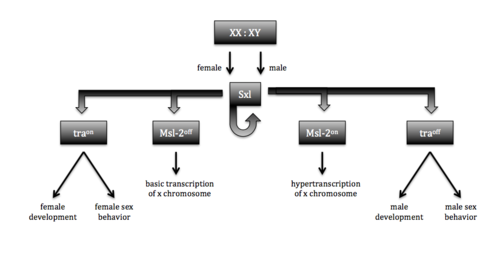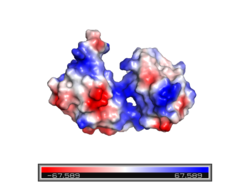User:Jeremy C. Caylor/Sandbox 1
From Proteopedia
| Line 9: | Line 9: | ||
<StructureSection load='1B7F' size='350' frame='true' side='right' caption='Sex lethal (PDB: 1B7F)' scene='78/782600/Opening_image/2'> | <StructureSection load='1B7F' size='350' frame='true' side='right' caption='Sex lethal (PDB: 1B7F)' scene='78/782600/Opening_image/2'> | ||
===RRMs=== | ===RRMs=== | ||
| - | [[Image:ElectroPOSITIVE.png|250 px|left|thumb|Figure 2. Electropositive binding cleft. Electropositive region shown in blue and electronegative region shown in red.]] The sex-lethal protein (Sxl) is 354 amino acid residues long. It is composed of two highly conserved regions called <scene name='78/782600/Rbd1_and_rbd2/4'>RNA recognition motifs</scene> (RRMs) that function as a monomeric unit. Each RRM is approximately 90 amino acids long with a four stranded sheet <scene name='78/782600/Opening_image/3'>β-pleated</scene> and two <scene name='78/782600/Alpha_helices/1'>α-helices</scene>. The β-pleated sheets from each RRM interact with the RNA ligand, while the α-helices interact with each other to shape the protein <ref name="Clery"/>. The RRMs interact at <scene name='78/782600/Inter-domain_interactions/ | + | [[Image:ElectroPOSITIVE.png|250 px|left|thumb|Figure 2. Electropositive binding cleft. Electropositive region shown in blue and electronegative region shown in red.]] The sex-lethal protein (Sxl) is 354 amino acid residues long. It is composed of two highly conserved regions called <scene name='78/782600/Rbd1_and_rbd2/4'>RNA recognition motifs</scene> (RRMs) that function as a monomeric unit. Each RRM is approximately 90 amino acids long with a four stranded sheet <scene name='78/782600/Opening_image/3'>β-pleated</scene> and two <scene name='78/782600/Alpha_helices/1'>α-helices</scene>. The β-pleated sheets from each RRM interact with the RNA ligand, while the α-helices interact with each other to shape the protein <ref name="Clery"/>. The RRMs interact at <scene name='78/782600/Inter-domain_interactions/5'>two places</scene>: between the side chain of Lys 197 and the main chain carbonyl of Val 238 and between the side chains of Tyr 131 and Gln 239<ref name="Handa" />. The two RRMs are connected via an <scene name='78/782600/Inter-domain_linker/2'>interdomain linker</scene>. The linker often forms a short 3<sub>10</sub> helix from Gly205 to Thr211.The interaction between the RRMs and the ligand is facilitated by the v-shaped <scene name='78/782600/Binding_cleft/7'>binding cleft</scene> formed by the β-pleated sheet of each RRM. The v-shaped cleft is strongly electropositive which also assists in ligand binding <ref name="Handa" /> (Figure 2). The presence of two RRMs increases RNA binding specificity by allowing for an elongated and continuous binding site <ref name="Clery">DOI 10.1016/j.sbi.2008.04.002</ref>. |
=== The Ligand=== | === The Ligand=== | ||
[[Image:Stacking.png|200 px|right|thumb|Figure 3: Intramolecular ring stacking of U7 (top) and U8 (bottom)]] The RNA <scene name='78/782599/Ligand_only/3'>ligand</scene> bound by Sxl is 9 nucleotides long—UGUUUUUUU. This ligand lacks intramolecular base pairs—a characteristic that would typically assist in RNA recognition—and therefore presents with many unique features. Sxl fixes U3-U11 in a specific elongated conformation. <scene name='78/782599/U6-11/3'>U6-U11</scene> interact within the strongly electropositive v-shaped cleft, while <scene name='78/782600/U3-u5/7'>U3-G4-U5</scene> are bound to a positively charged surface on RRM2 <ref name="Handa" />. The kink in the middle of the ligand is created by hydrogen bonds between the 2’OH's of U5 and U6 and the phosphate group of U8, as well as between the 2’OH of U7 and the phosphate group of U5. This is kink is also facilitated by the only intramolecular stacking pair in the ligand, U7 and U8 (Figure 3). All of the nucleotides besides U8 are in the [http://x3dna.org/highlights/sugar-pucker-correlates-with-phosphorus-base-distance C2’-endo] conformation. This orientation allows the bases to be highly exposed to the protein and therefore increases specificity. The low number of intramolecular stacking regions and the large number of C2’-endo conformations deem this ligand unique<ref name="Handa" />. | [[Image:Stacking.png|200 px|right|thumb|Figure 3: Intramolecular ring stacking of U7 (top) and U8 (bottom)]] The RNA <scene name='78/782599/Ligand_only/3'>ligand</scene> bound by Sxl is 9 nucleotides long—UGUUUUUUU. This ligand lacks intramolecular base pairs—a characteristic that would typically assist in RNA recognition—and therefore presents with many unique features. Sxl fixes U3-U11 in a specific elongated conformation. <scene name='78/782599/U6-11/3'>U6-U11</scene> interact within the strongly electropositive v-shaped cleft, while <scene name='78/782600/U3-u5/7'>U3-G4-U5</scene> are bound to a positively charged surface on RRM2 <ref name="Handa" />. The kink in the middle of the ligand is created by hydrogen bonds between the 2’OH's of U5 and U6 and the phosphate group of U8, as well as between the 2’OH of U7 and the phosphate group of U5. This is kink is also facilitated by the only intramolecular stacking pair in the ligand, U7 and U8 (Figure 3). All of the nucleotides besides U8 are in the [http://x3dna.org/highlights/sugar-pucker-correlates-with-phosphorus-base-distance C2’-endo] conformation. This orientation allows the bases to be highly exposed to the protein and therefore increases specificity. The low number of intramolecular stacking regions and the large number of C2’-endo conformations deem this ligand unique<ref name="Handa" />. | ||
Revision as of 17:40, 20 April 2018
Contents |
Sex lethal: RNA-binding protein
Introduction

Structure
| |||||||||||
Autoregulation
Sxl controls its own levels of expression via positive and negative autoregulation. Sxl binds its own pre-mRNA transcript in a similar manner as its downstream targets, Tra and Msl2. Through binding to its recognition element, Sxl causes a 3’ splice site to be skipped. Alternative splicing occurs utilizing a 3’ splice site further downstream, cleaving out a premature stop codon within Exon 3 and preventing truncation and inactivation[1]. This is a pathway of positive autoregulation, as functional Sxl protein must be present to cause proper processing of the pre-mRNA. The negative autoregulation pathway of Sxl proceeds via repression of its own translation. The Sxl transcript contains the target polyuridine sequence within its 3’UTR. Sxl binds this target, and blocks translation[1]. Negative autoregulation allows maintenance of a stable and standard Sxl protein concentration. An excess of Sxl increases the degree of translation repression because more Sxl protein are present to potentially bind at the 3’UTR, while a shortage allows for more unrepressed translation.
Mutation
In fruit flies, dosage compensation is achieved by hyperexpression of the single X chromosome found in the male genome. The single X chromosome is hyperexpressed and regulated by a group of genes known as the Male-specific lethal genes. The genes involve work together to produce a complex known as the Male-specific lethal complex (Msl complex). One gene that is important in forming this complex is the gene that codes for the Msl-2 protein. Without this protein, the Msl complex cannot form [5]. Males exclusively make the Msl-2 protein and therefore exclusively create the Msl complex. Female cannot make the complex because the Sxl protein prevents the production of the Msl-2 protein. It prevents the protein formation by alternatively splicing of an intron near the 5’ UTR. In males this intron is included and in females it is not. [5] Mutations of the Sxl protein can affect the formation of this complex and lead to death for females—hence the name sex lethal. If the Sxl gene is mutated in females, the formation of the Msl-2 complex will not be inhibited. If there is a functional Msl-2 complex in females then both of the X chromosomes will be hyperexpressed [5] The overexpression of genes on the X chromosome is a fatal phenomenon ultimately caused by a mutation of the Sxl protein. Although a mutation to the Sxl gene is harmful to females, it has no effect on males because the functional Sxl gene is not expressed—a mutation in males has no phenotypic effect.
References
- ↑ 1.0 1.1 1.2 1.3 1.4 Black DL. Mechanisms of alternative pre-messenger RNA splicing. Annu Rev Biochem. 2003;72:291-336. doi: 10.1146/annurev.biochem.72.121801.161720., Epub 2003 Feb 27. PMID:12626338 doi:http://dx.doi.org/10.1146/annurev.biochem.72.121801.161720
- ↑ 2.0 2.1 2.2 2.3 2.4 2.5 2.6 2.7 Handa N, Nureki O, Kurimoto K, Kim I, Sakamoto H, Shimura Y, Muto Y, Yokoyama S. Structural basis for recognition of the tra mRNA precursor by the Sex-lethal protein. Nature. 1999 Apr 15;398(6728):579-85. PMID:10217141 doi:10.1038/19242
- ↑ Georgiev P, Chlamydas S, Akhtar A. Drosophila dosage compensation. Fly 2011;5(2):147-154. https://doi.org/10.4161/fly.5.2.14934
- ↑ 4.0 4.1 Clery A, Blatter M, Allain FH. RNA recognition motifs: boring? Not quite. Curr Opin Struct Biol. 2008 Jun;18(3):290-8. doi: 10.1016/j.sbi.2008.04.002. PMID:18515081 doi:http://dx.doi.org/10.1016/j.sbi.2008.04.002
- ↑ 5.0 5.1 5.2 Penalva L, Sanchez L. RNA Binding Protein Sex-Lethal (Sxl) and Control of Drosophila Sex Determination and Dosage Compensation. Microbiol Mol Biol Rev.;67(3):343-356. doi: 10.1128/MMBR.67.3.343–359.2003


